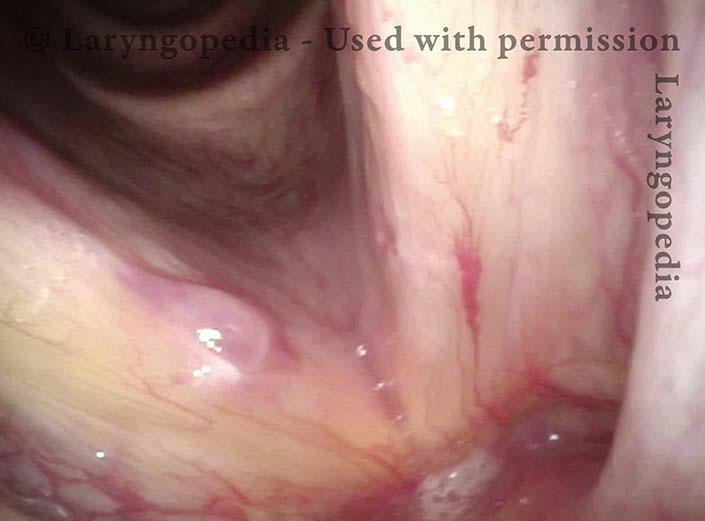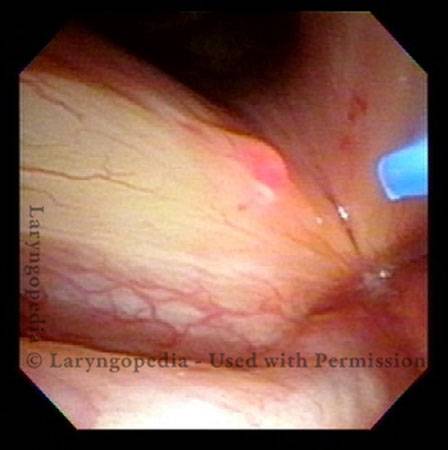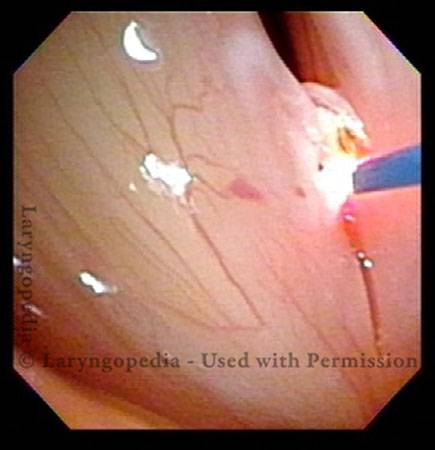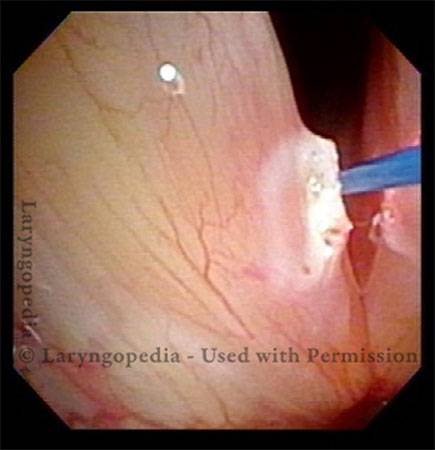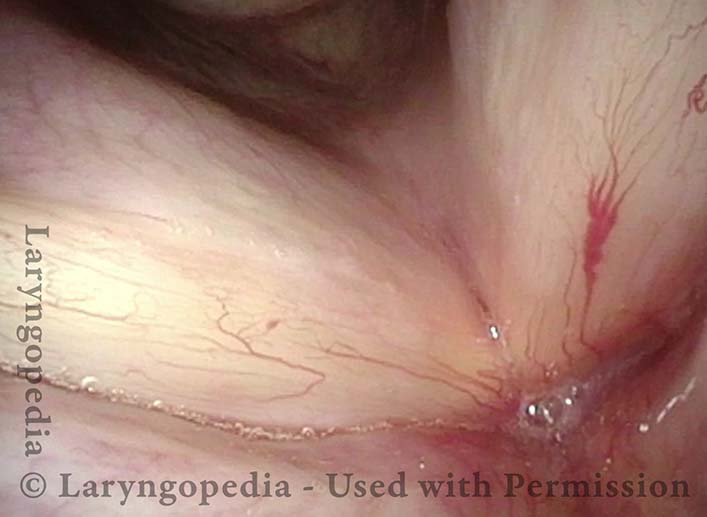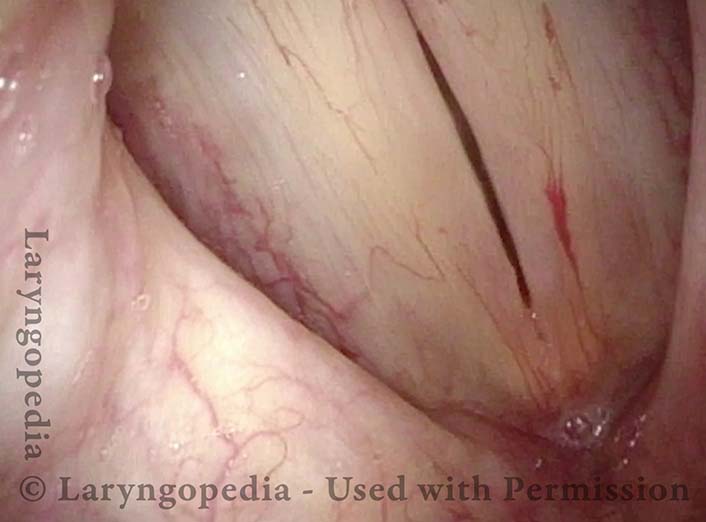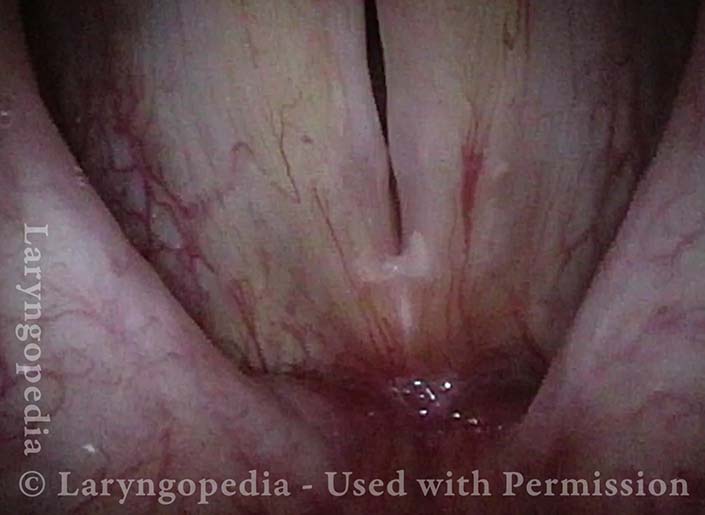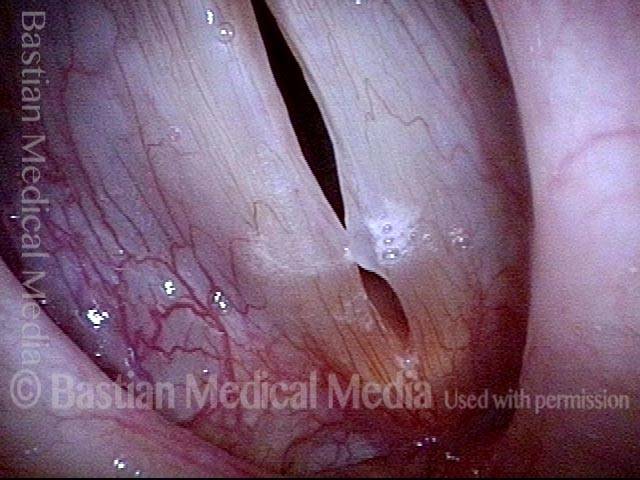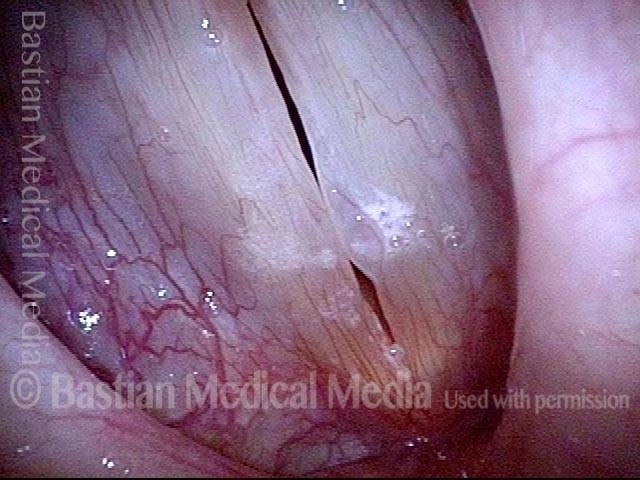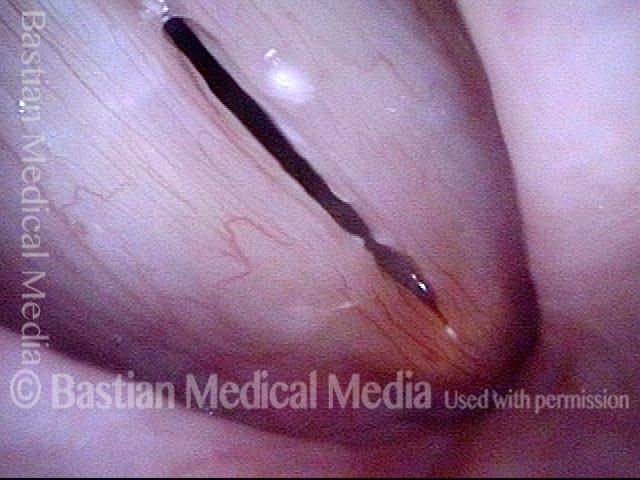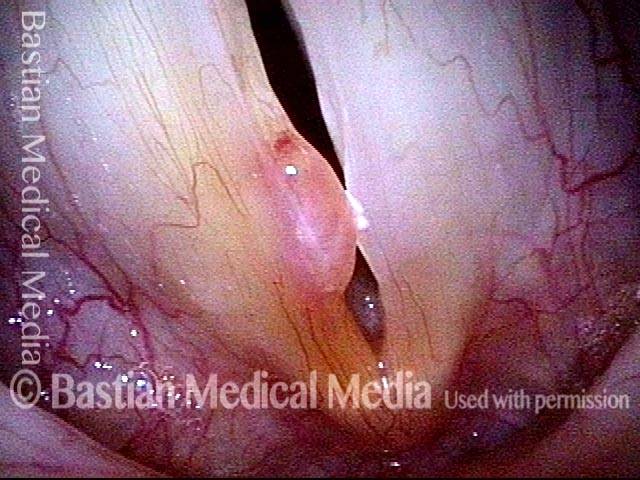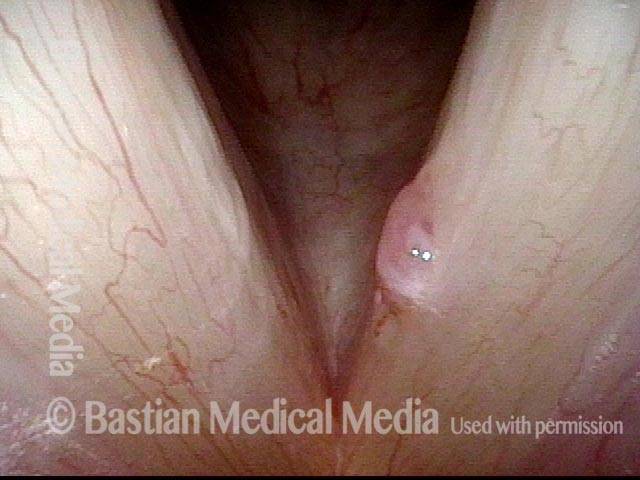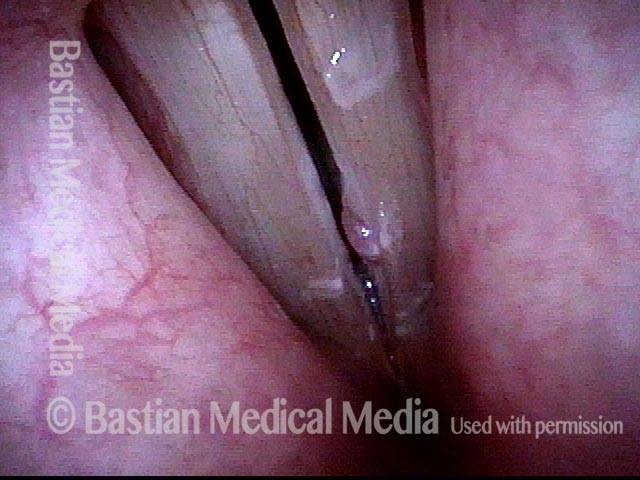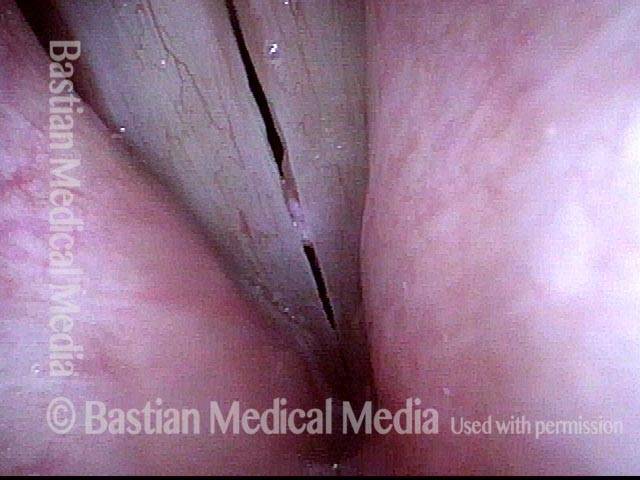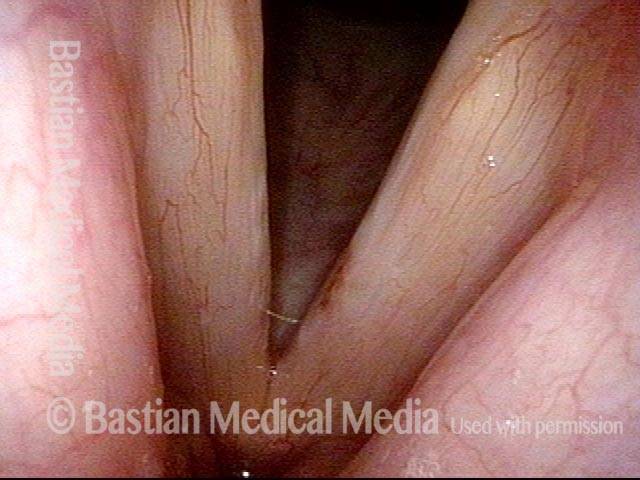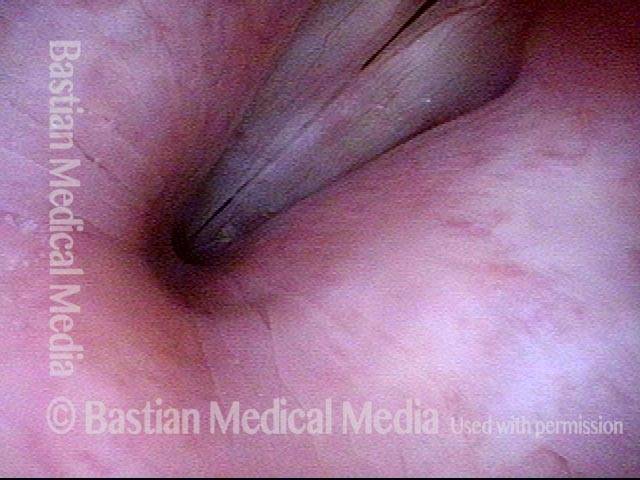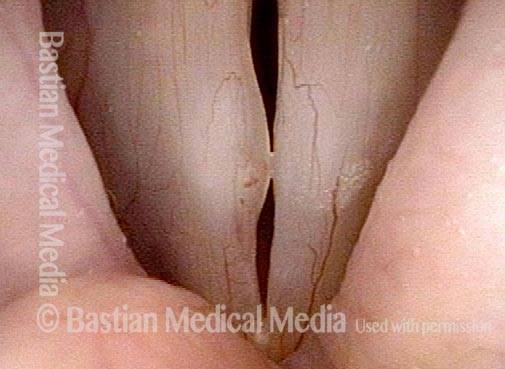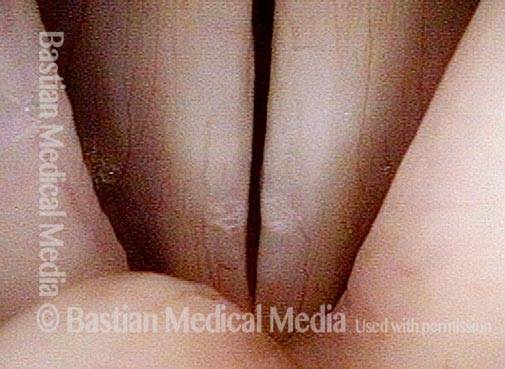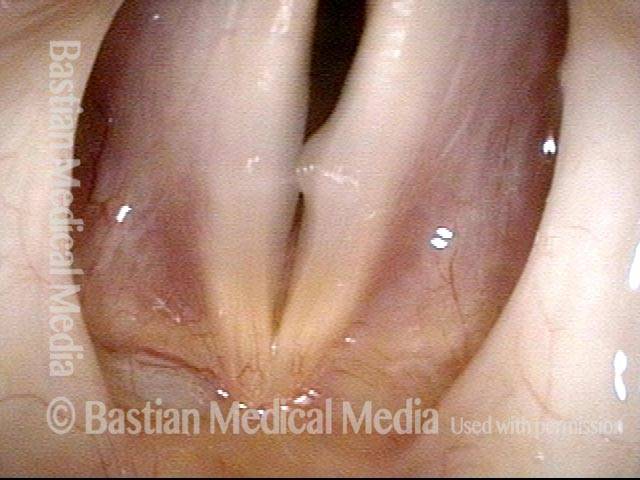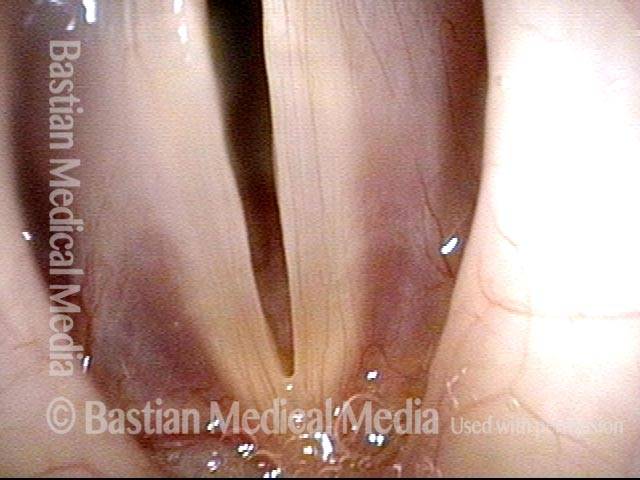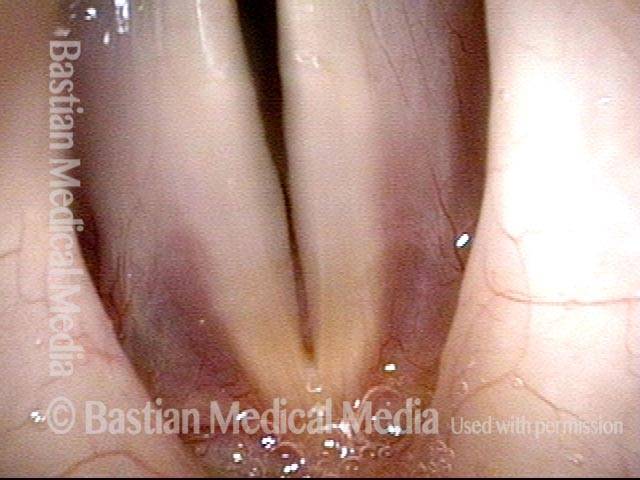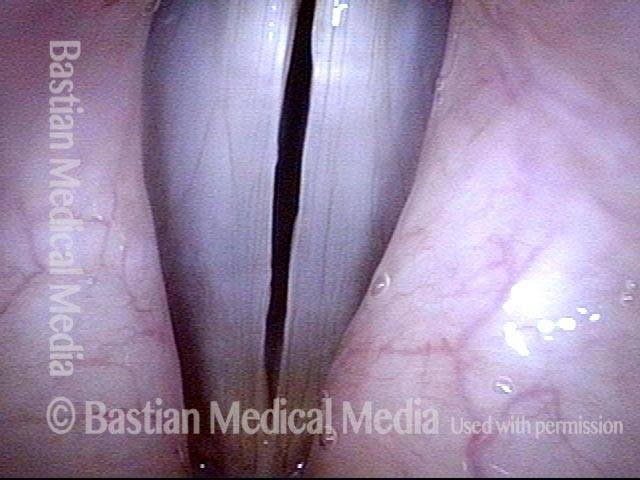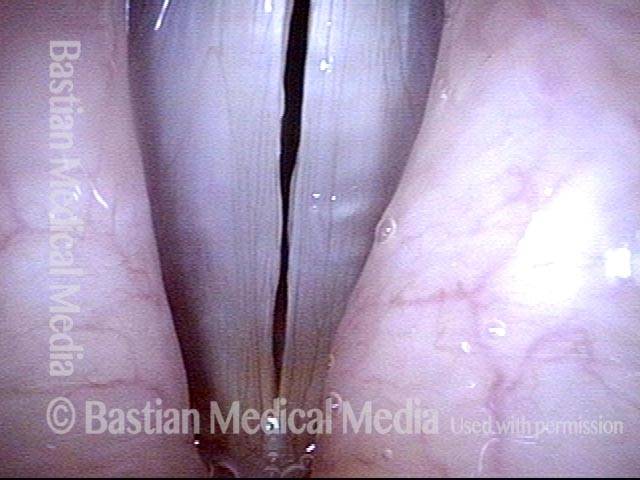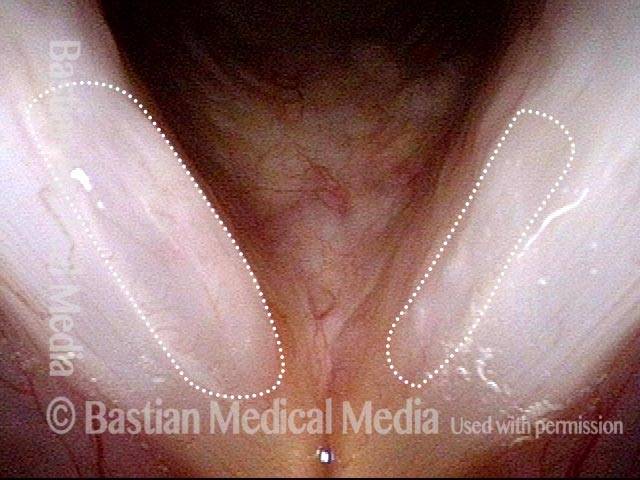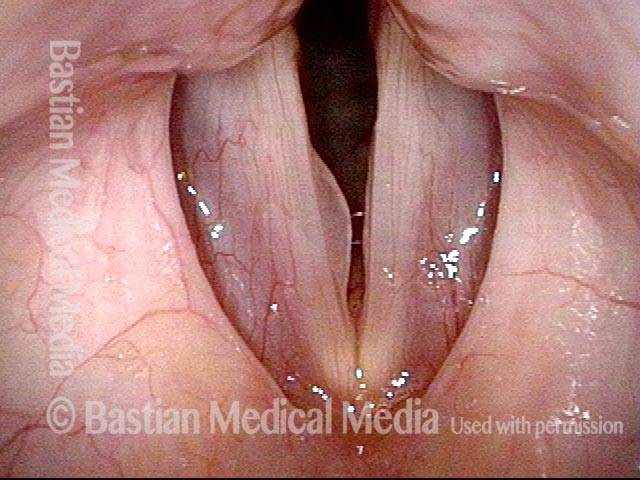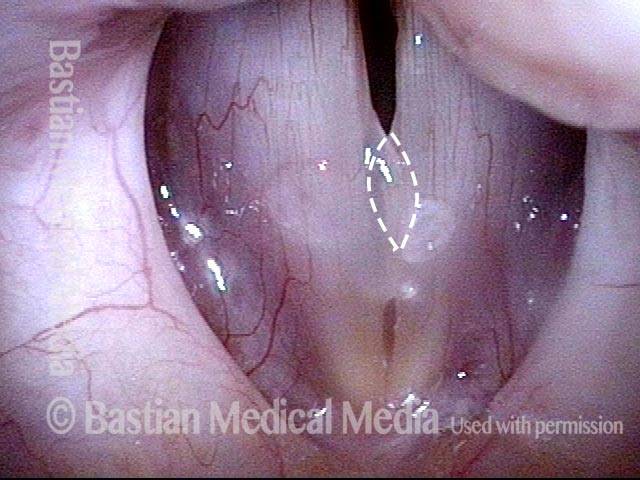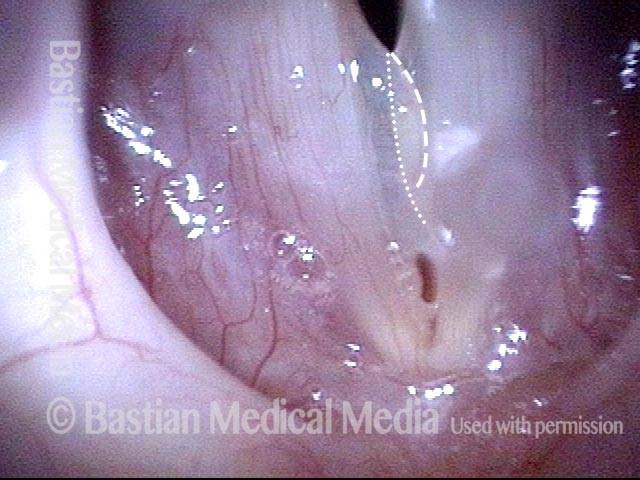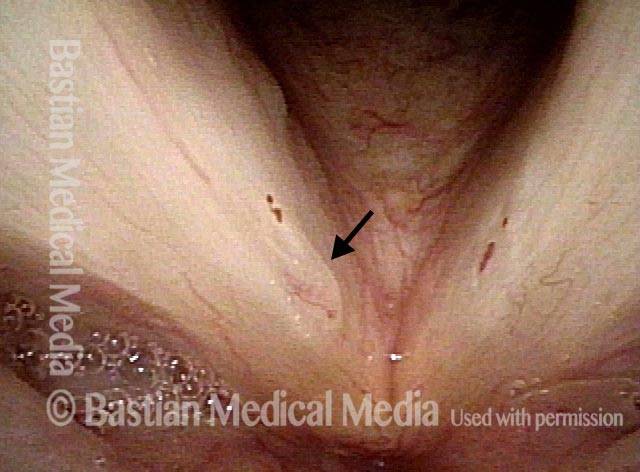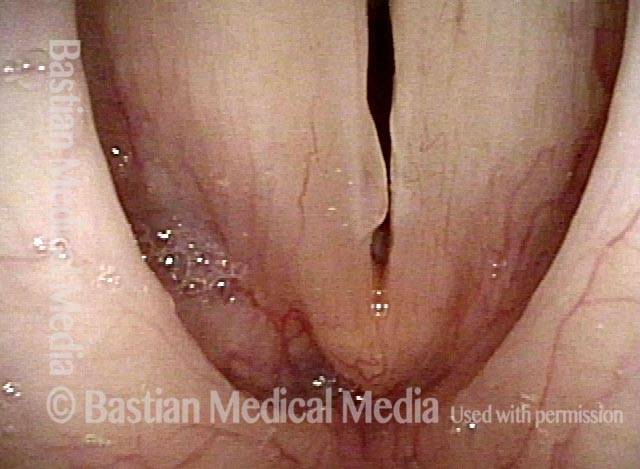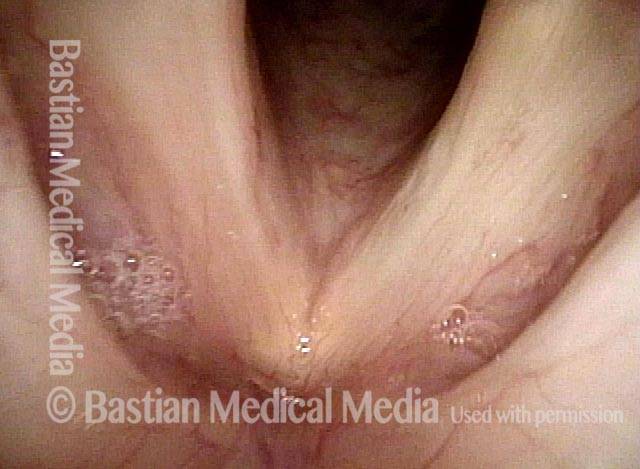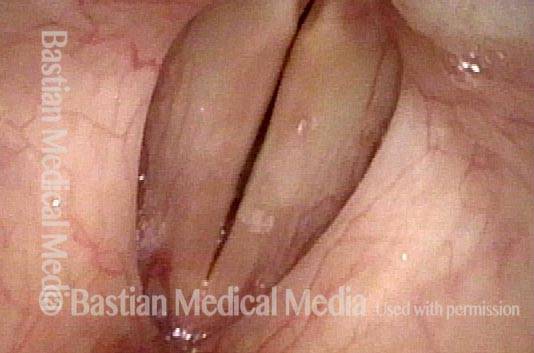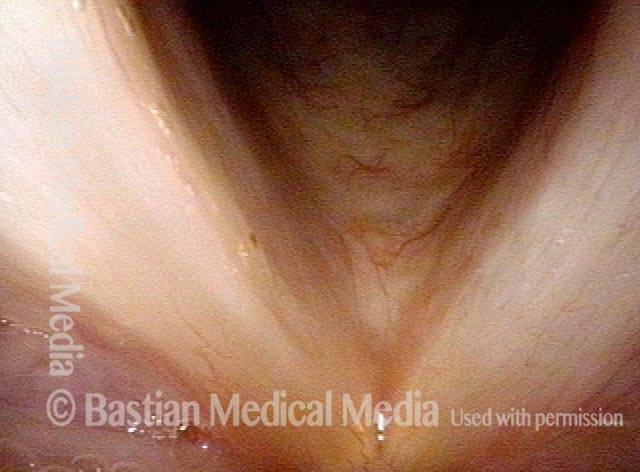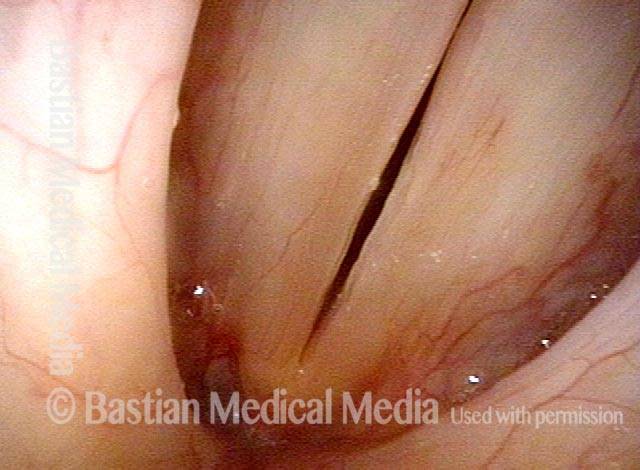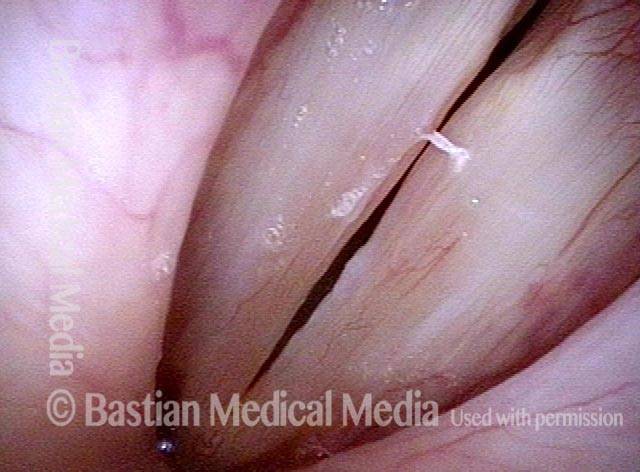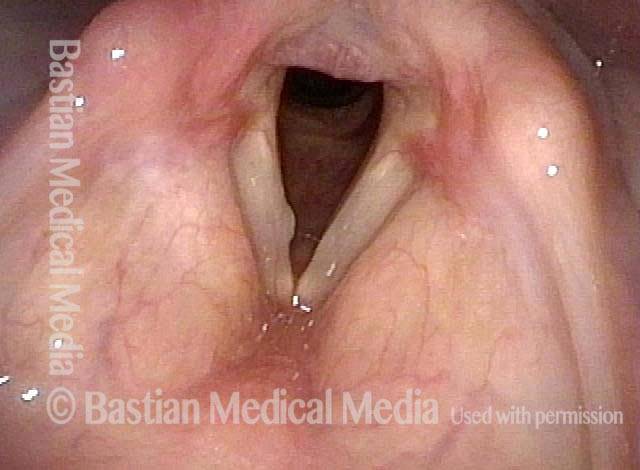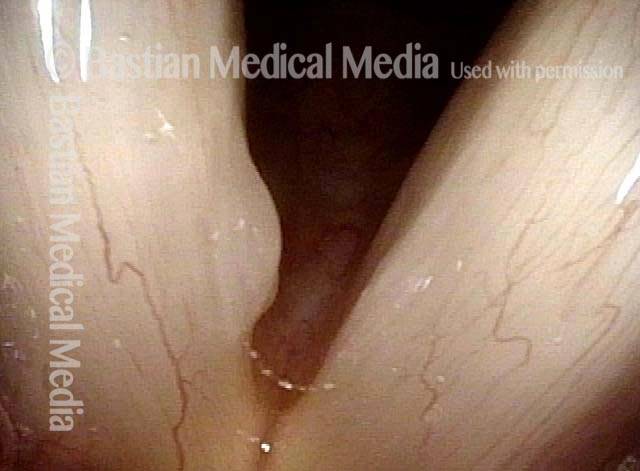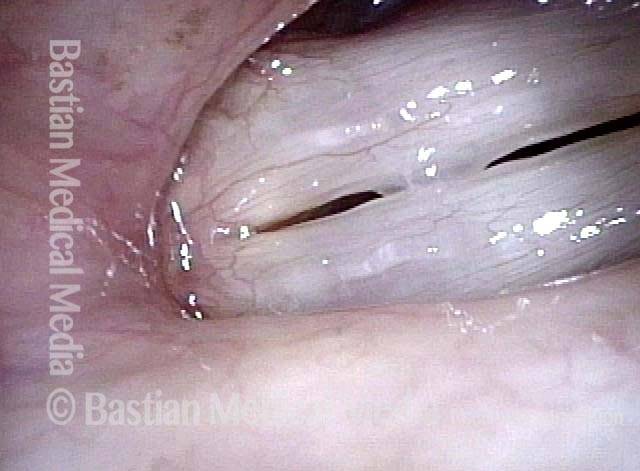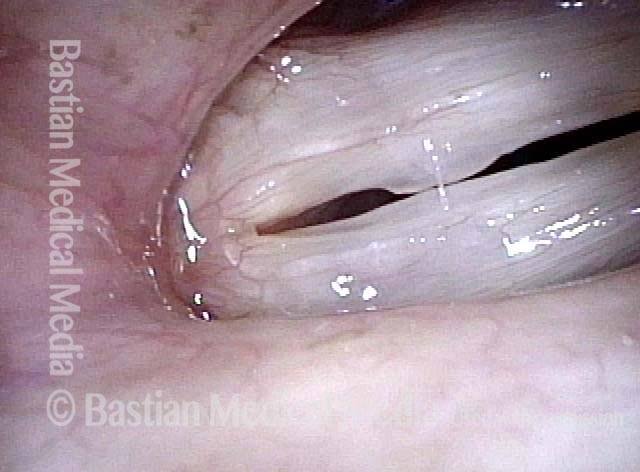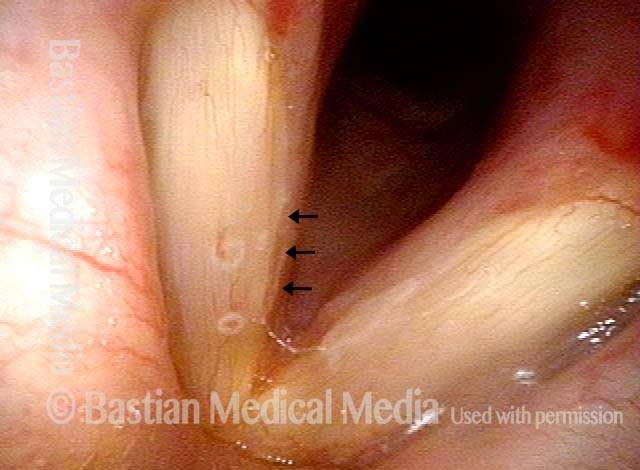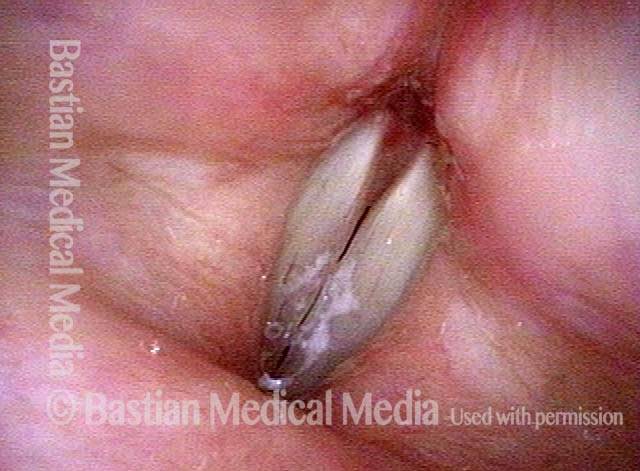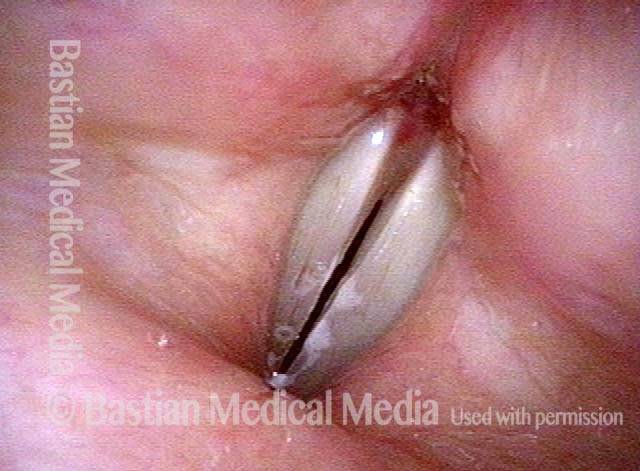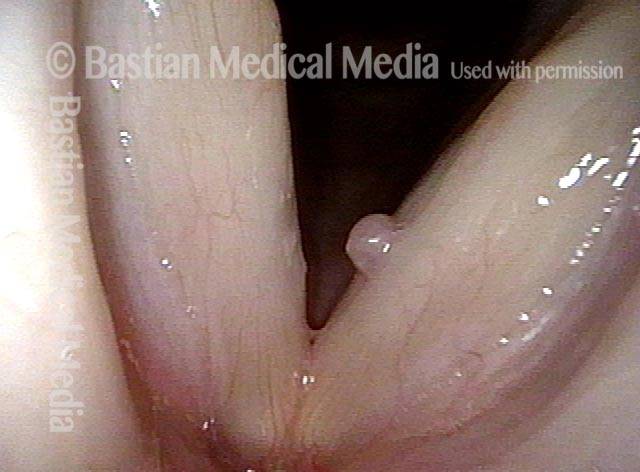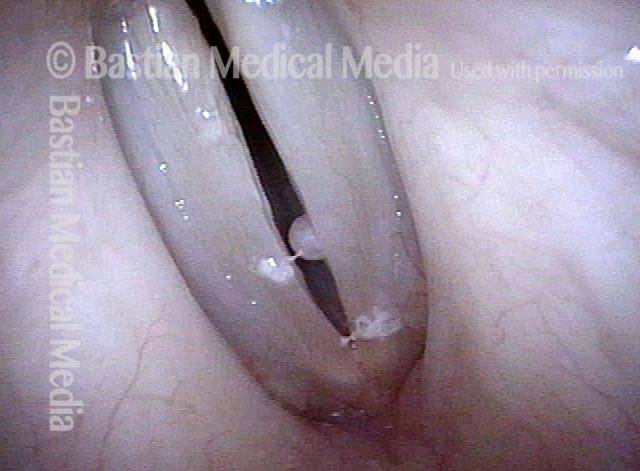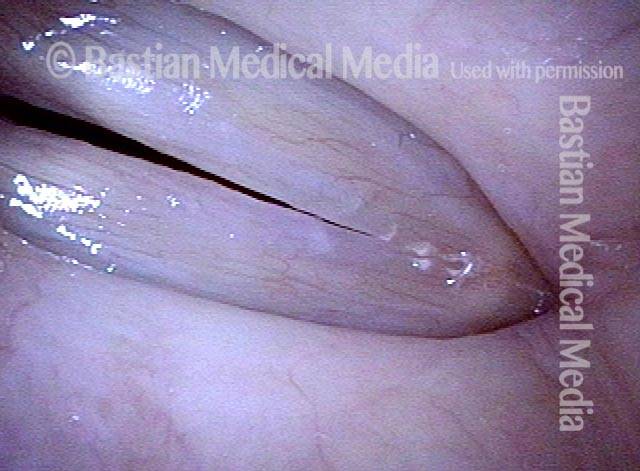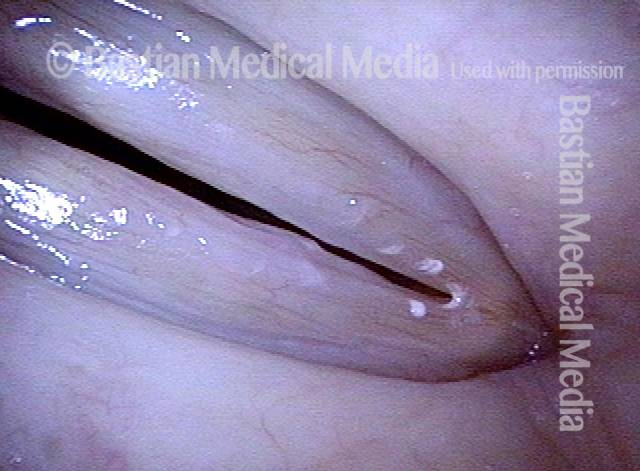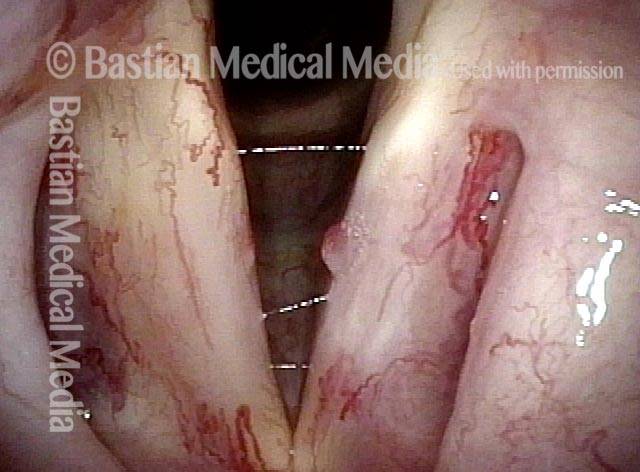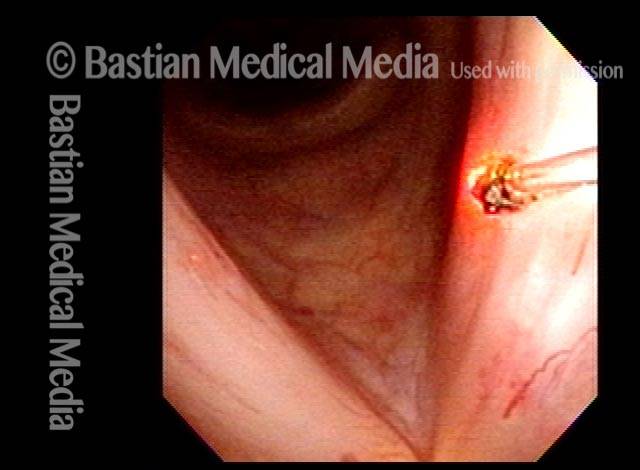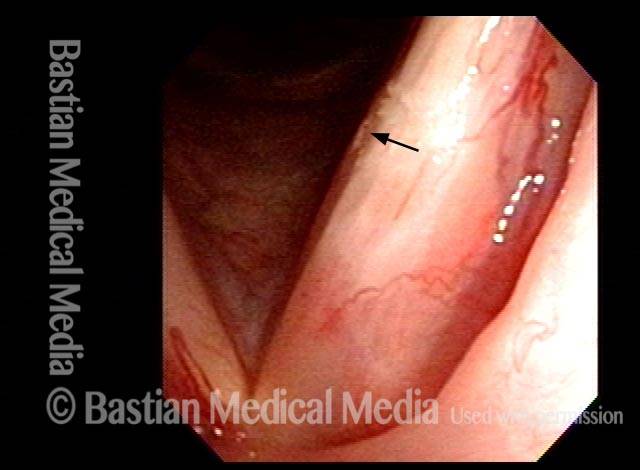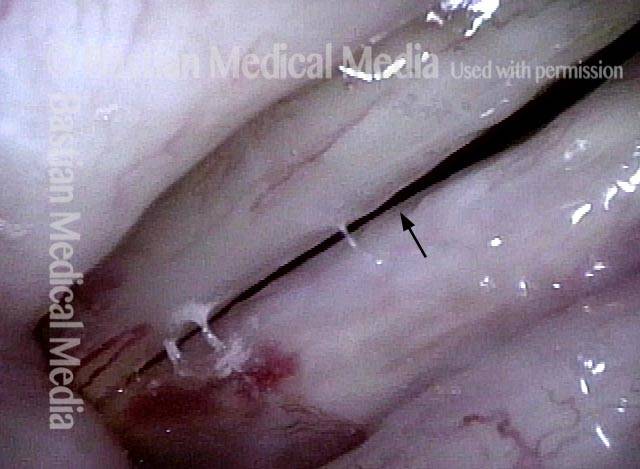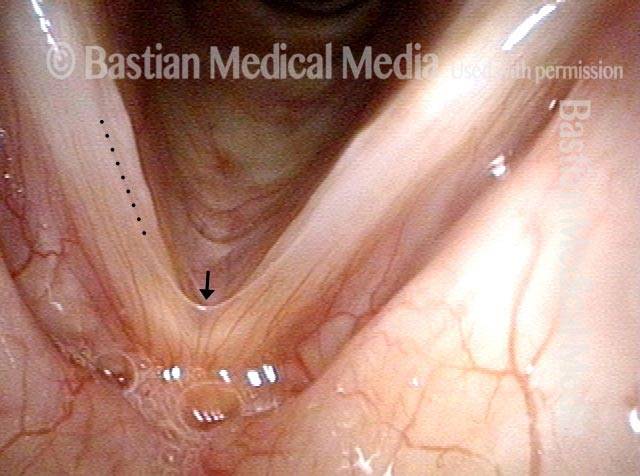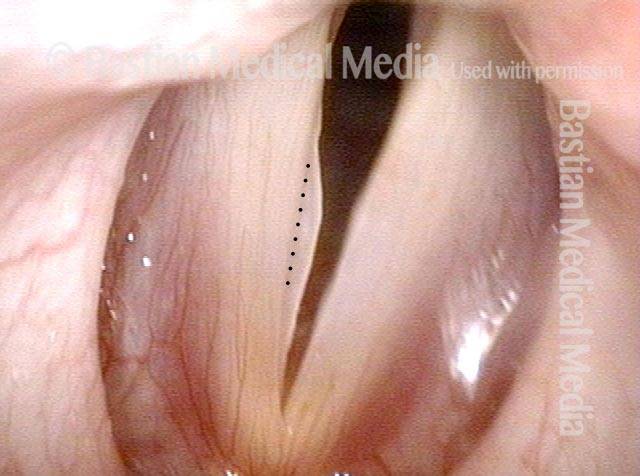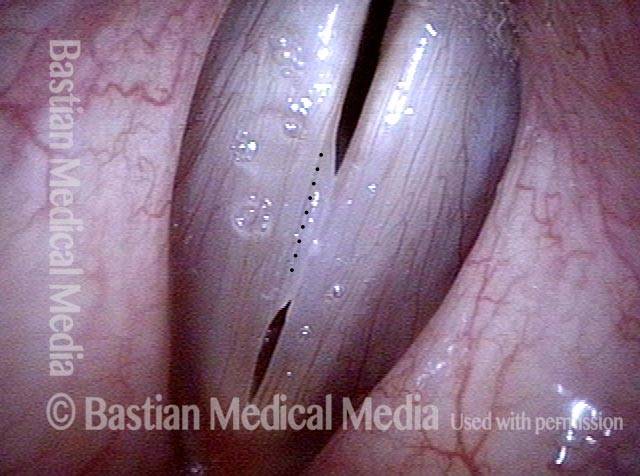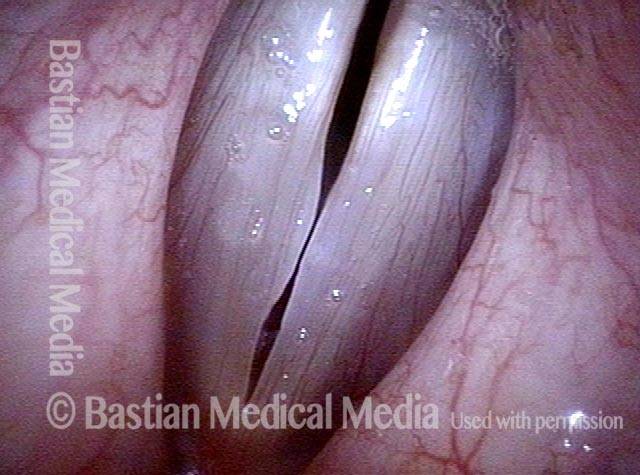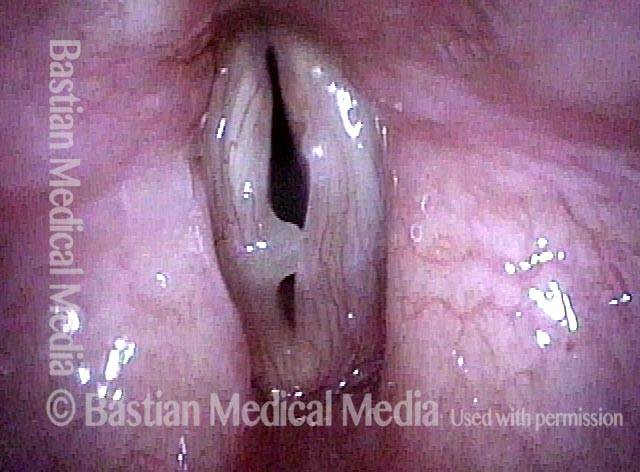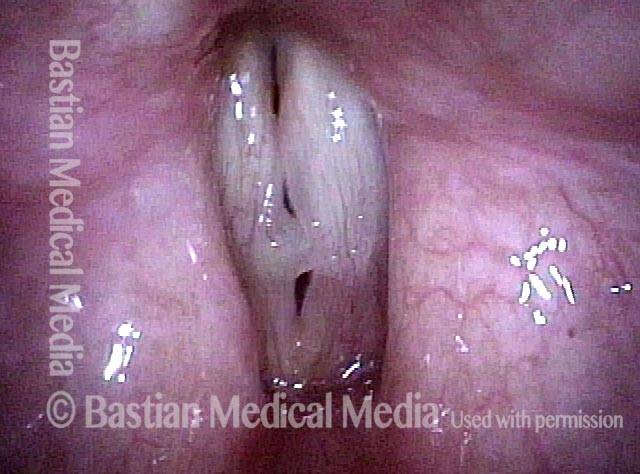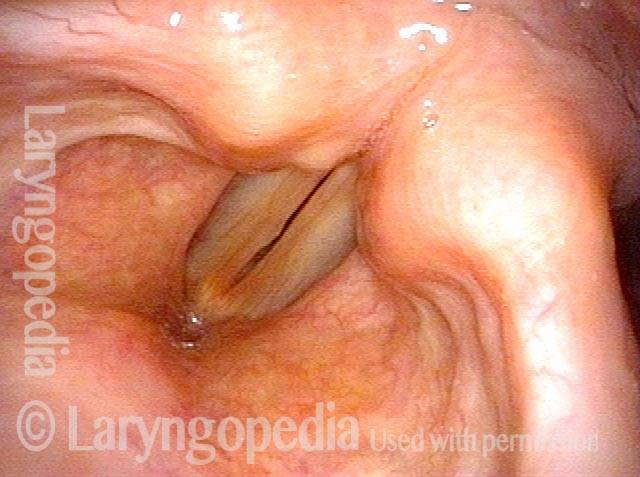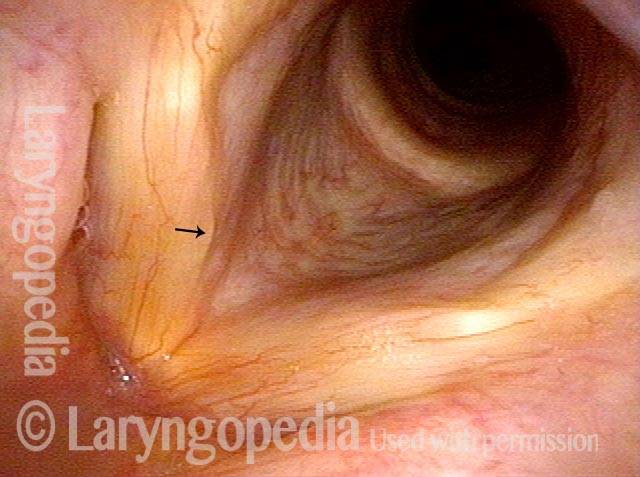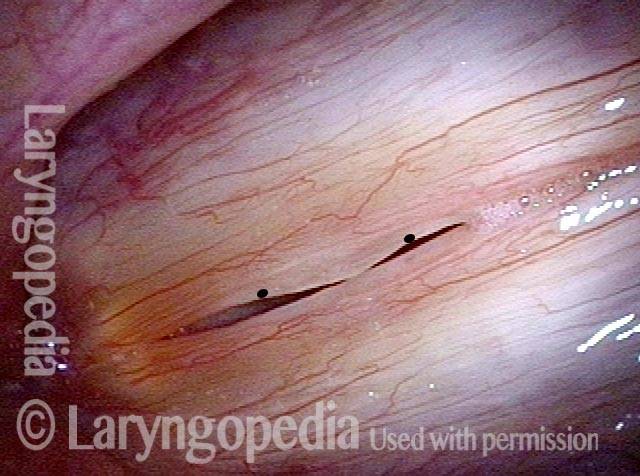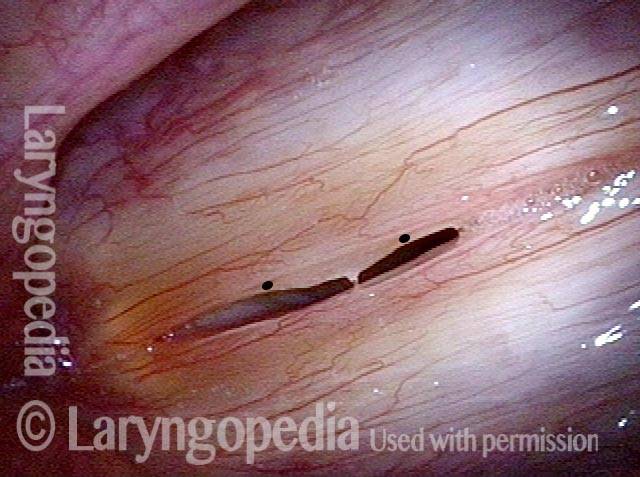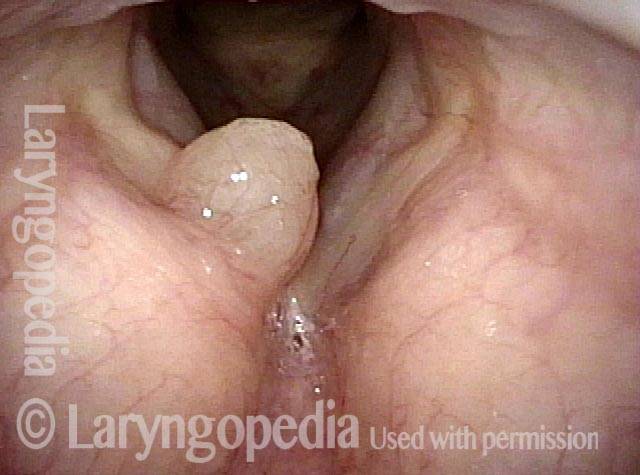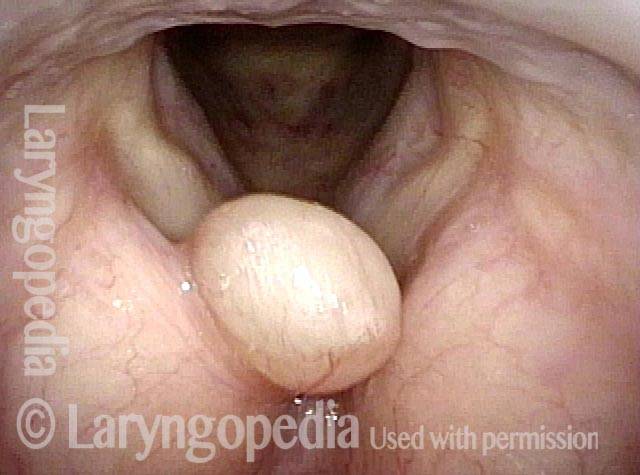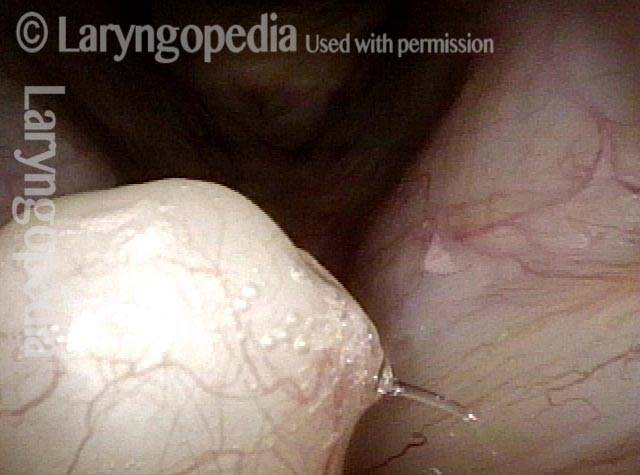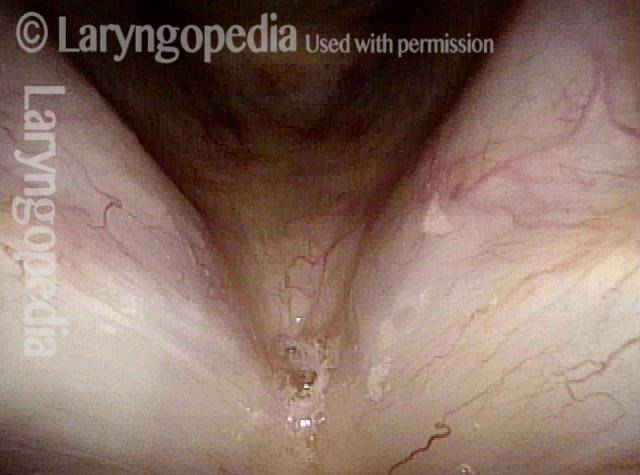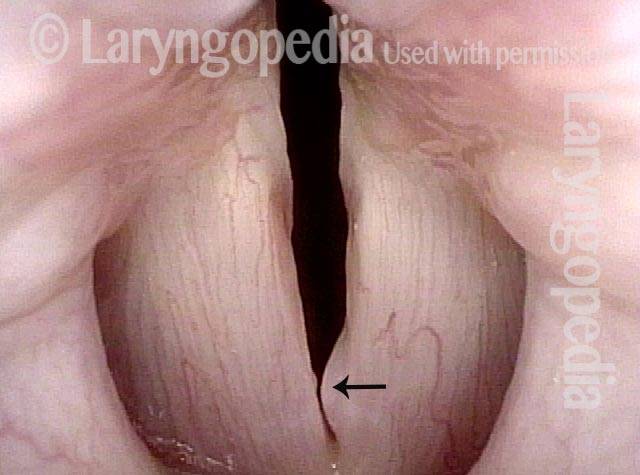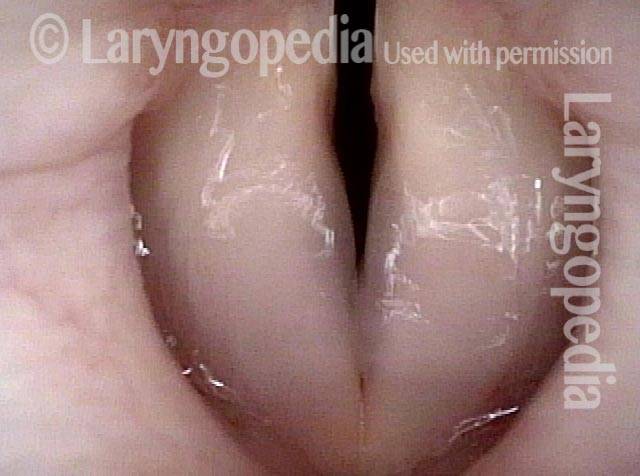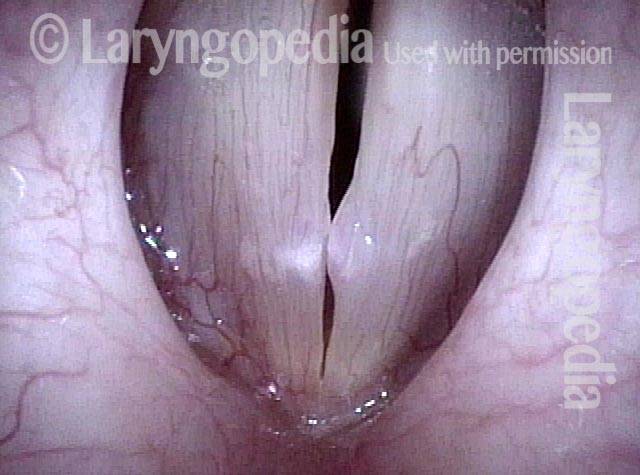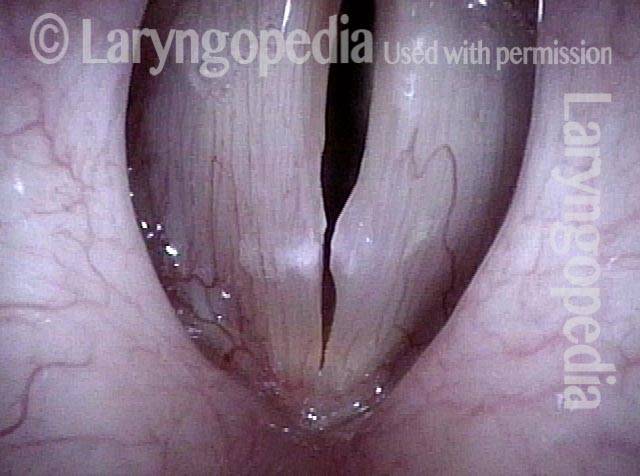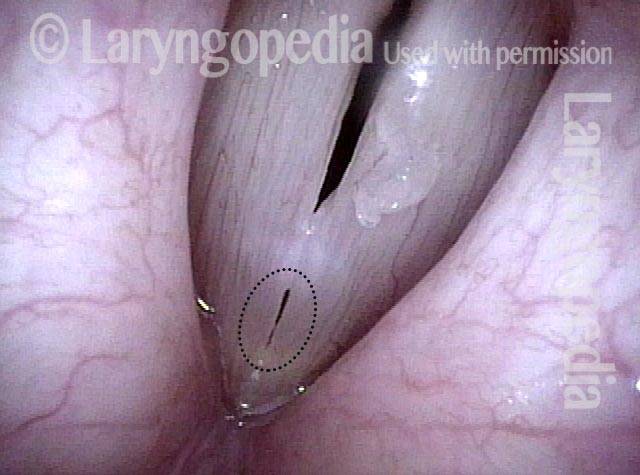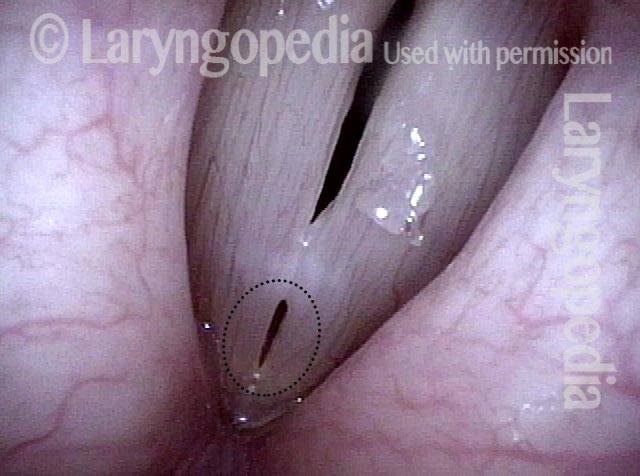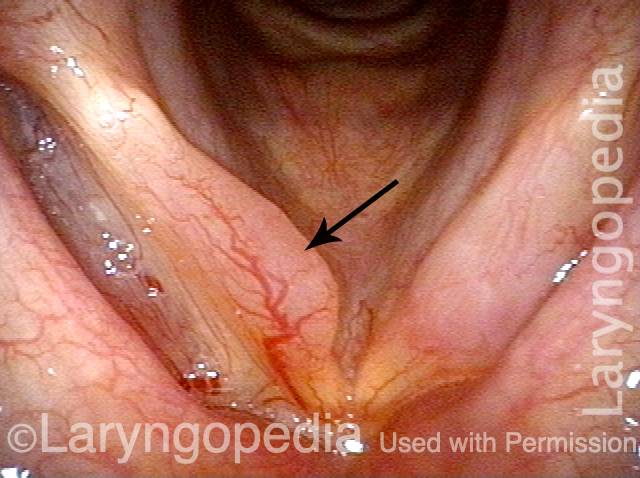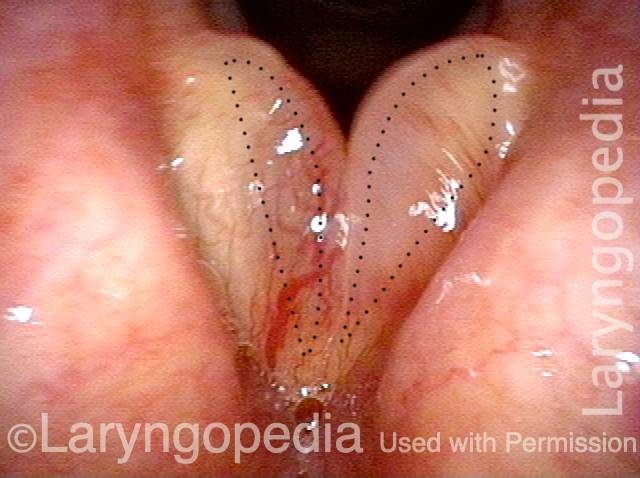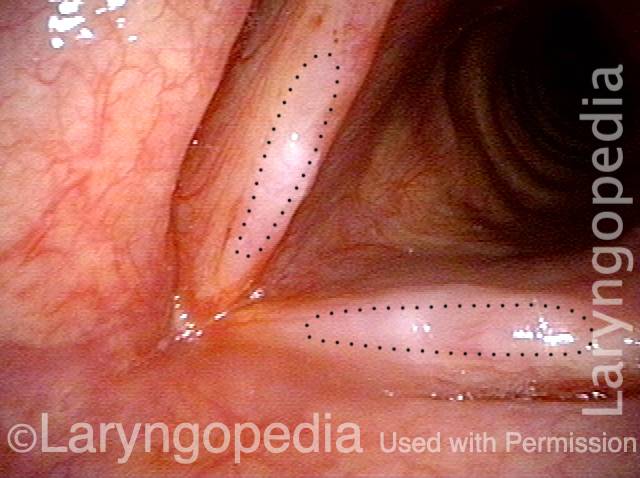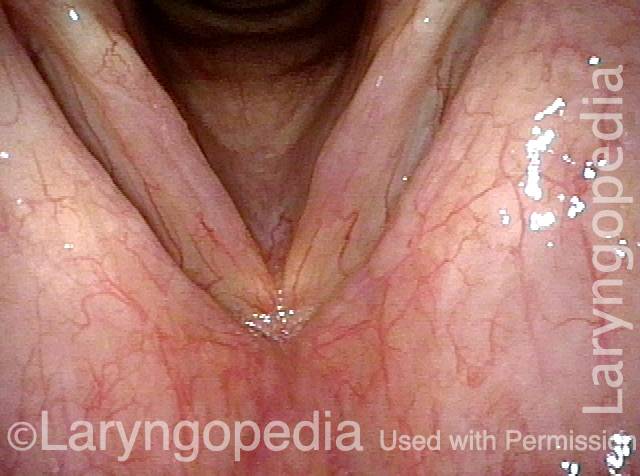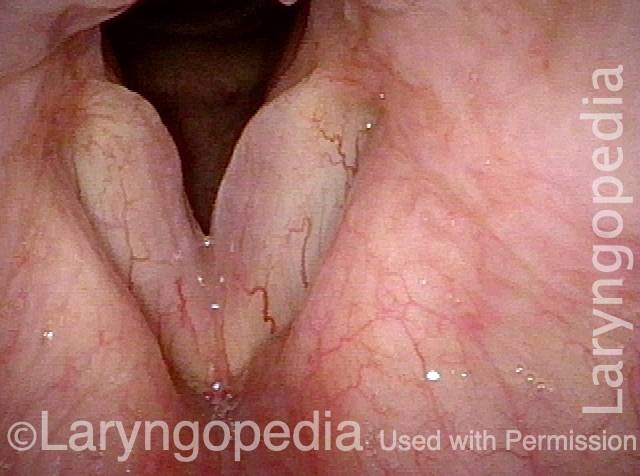Vocal Polyp
Vocal polyp is a large swelling on the vocal cord that typically occurs unilaterally—that is, without a similar swelling on the opposite cord. The term vocal polyp is somewhat imprecise, but vocal polyps can be distinguished from a similar kind of swelling, vocal nodules, in at least two ways:
- Polyps tend to be larger than nodules
- Polyps occur unilaterally or are markedly larger than an injury of the opposite vocal cord, whereas nodules occur in pairs and are usually similar in size.
Both vocal polyps and nodules are caused at least in part by vibratory trauma, due to vocal overuse that is acute (with polyps) or chronic.
A vocal polyp disrupts the voice’s clarity and other capabilities by interfering with accurate approximation of the vocal cords during phonation. A polyp may also add mass to the vocal cord, thereby dropping the pitch range available to the voice. Polyps may be referred to as hemorrhagic, pedunculated, and so forth.
Office Laser, Even Occasionally for Singers
Ordinarily, vocal cord microsurgery is only for otherwise irreversible lesions. This is especially so in singers, even though when done well, such surgery is extremely safe and voice restoring. And if time and therapy approaches fail to resolve a lesion, the typical venue for surgery is in the operating room under brief general anesthesia, with use of an operating microscope and tiny instruments.
Still, there is an office option that can occasionally be considered. Capillary ectasia without a nodule or polyp, for example, can be well managed in the videoendoscopy procedure room using only topical anesthesia. And there are circumstances (medical issues, jaw anatomy, etc.) that cause a specific singer to prefer office-based laser surgery with pulsed-KTP, thulium, or “blue” laser.
Right Vocal Cord Polyp (1 of 8)
Right Vocal Cord Polyp (1 of 8)
Polyp interferes with voice (2 of 8)
Polyp interferes with voice (2 of 8)
Laser surgery in singer (3 of 8)
Laser surgery in singer (3 of 8)
Coagulated polyp (4 of 8)
Coagulated polyp (4 of 8)
Coagulated polyp (5 of 8)
Coagulated polyp (5 of 8)
Voice fully restored (6 of 8)
Voice fully restored (6 of 8)
Margins match during phonation (7 of 8)
Margins match during phonation (7 of 8)
Equal vibration (8 of 8)
Equal vibration (8 of 8)
Vocal Polyp, Removed and then Recurring
Vocal polyp (1 of 4)
Vocal polyp (1 of 4)
Vocal polyp (2 of 4)
Vocal polyp (2 of 4)
Vocal polyp, one week after surgical removal (3 of 4)
Vocal polyp, one week after surgical removal (3 of 4)
Vocal polyp, subsequent new injury (4 of 4)
Vocal polyp, subsequent new injury (4 of 4)
Vocal Polyp, Before and After Surgery
Vocal polyp (1 of 6)
Vocal polyp (1 of 6)
Vocal polyp (2 of 6)
Vocal polyp (2 of 6)
Vocal polyp (3 of 6)
Vocal polyp (3 of 6)
Vocal polyp, surgically removed (4 of 6)
Vocal polyp, surgically removed (4 of 6)
Vocal polyp, surgically removed (5 of 6)
Vocal polyp, surgically removed (5 of 6)
Vocal polyp, surgically removed (6 of 6)
Vocal polyp, surgically removed (6 of 6)
Example 2
Vocal polyp (1 of 2)
Vocal polyp (1 of 2)
Vocal polyp, surgically removed (2 of 2)
Vocal polyp, surgically removed (2 of 2)
Example 3
Vocal polyp (1 of 6)
Vocal polyp (1 of 6)
Vocal polyp (2 of 6)
Vocal polyp (2 of 6)
Vocal polyp, surgically removed (3 of 6)
Vocal polyp, surgically removed (3 of 6)
Vocal polyp, surgically removed (4 of 6)
Vocal polyp, surgically removed (4 of 6)
Vocal polyp, surgically removed (5 of 6)
Vocal polyp, surgically removed (5 of 6)
Vocal polyp, surgically removed (6 of 6)
Vocal polyp, surgically removed (6 of 6)
Translucent Polyp
Translucent polyp (1 of 4)
Translucent polyp (1 of 4)
Translucent polyp (2 of 4)
Translucent polyp (2 of 4)
Translucent polyp (3 of 4)
Translucent polyp (3 of 4)
Translucent polyp (4 of 4)
Translucent polyp (4 of 4)
Opera Singer’s Polyp Removed with Restoration of Original Capabilities
Polyp and capillary ectasia (1 of 8)
Polyp and capillary ectasia (1 of 8)
Prephonatory instant (2 of 8)
Prephonatory instant (2 of 8)
One week post-op (3 of 8)
One week post-op (3 of 8)
Prephonatory instant (4 of 8)
Prephonatory instant (4 of 8)
One month post-op (5 of 8)
One month post-op (5 of 8)
Prephonatory instant (6 of 8)
Prephonatory instant (6 of 8)
Closed phase (7 of 8)
Closed phase (7 of 8)
Open phase (8 of 8)
Open phase (8 of 8)
An Actress’ Polyp Before and Hours After Surgical Removal
Vocal cord polyp (1 of 8)
Vocal cord polyp (1 of 8)
Closer view (2 of 8)
Closer view (2 of 8)
Closed phase (3 of 8)
Closed phase (3 of 8)
24 hours post surgery (5 of 8)
24 hours post surgery (5 of 8)
Primary “wound” (6 of 8)
Primary “wound” (6 of 8)
Closed phase (7 of 8)
Closed phase (7 of 8)
Open phase (8 of 8)
Open phase (8 of 8)
Operated Cord Looks Better than the Unoperated Cord
Singer with chronic hoarseness (1 of 4)
Singer with chronic hoarseness (1 of 4)
Attempting phonation (2 of 4)
Attempting phonation (2 of 4)
One week post surgical removal (3 of 4)
One week post surgical removal (3 of 4)
Open phase (4 of 4)
Open phase (4 of 4)
Office Laser of Post-radiation Telangiectatic Polyp
Post-radiation telangiectasias (1 of 4)
Post-radiation telangiectasias (1 of 4)
Pulsed-KTP coagulation (2 of 4)
Pulsed-KTP coagulation (2 of 4)
“Polyp” pulled off (3 of 4)
“Polyp” pulled off (3 of 4)
Three weeks later (4 of 4)
Three weeks later (4 of 4)
Nuances “Gleaned” from Daily Examinations
Vocal “overdoer” (1 of 4)
Vocal “overdoer” (1 of 4)
Inspiratory phonation (2 of 4)
Inspiratory phonation (2 of 4)
Translucent polyp (3 of 4)
Translucent polyp (3 of 4)
Open phase (4 of 4)
Open phase (4 of 4)
The Mucosa’s Expression of Injury Varies
Vocal cord injuries (1 of 4)
Vocal cord injuries (1 of 4)
Narrow band lighting (2 of 4)
Narrow band lighting (2 of 4)
Strobe lighting (3 of 4)
Strobe lighting (3 of 4)
Phonation (4 of 4)
Phonation (4 of 4)
The Power of “Close-clear” Not “Far-fuzzy” to See a Polyp
Disant view (1 of 4)
Disant view (1 of 4)
Closer view (2 of 4)
Closer view (2 of 4)
Close-clear view (3 of 4)
Close-clear view (3 of 4)
Open phase (4 of 4)
Open phase (4 of 4)
Polyp or Cyst?
Hoarseness (1 of 4)
Hoarseness (1 of 4)
Position of lesion (2 of 4)
Position of lesion (2 of 4)
Close view (3 of 4)
Close view (3 of 4)
Anterior saccular cyst (4 of 4)
Anterior saccular cyst (4 of 4)
Tiny Vibrating Segment Gives Tiny Tin Whistle Voice
Prephonatory instant (1 of 6)
Prephonatory instant (1 of 6)
Phonation (2 of 6)
Phonation (2 of 6)
Gaps due to nodules (3 of 6)
Gaps due to nodules (3 of 6)
Open phase (4 of 6)
Open phase (4 of 6)
“Tin whistle” sound (5 of 6)
“Tin whistle” sound (5 of 6)
“Tin whistle” at open vibration (6 of 6)
“Tin whistle” at open vibration (6 of 6)
Smoker’s Polyp Reduction Improves Voice Even Though the Larynx Result May not be “Pretty”
Smokers Polyp (1 of 5)
Smokers Polyp (1 of 5)
Reine’s edema (2 of 5)
Reine’s edema (2 of 5)
A week after surgery (3 of 5)
A week after surgery (3 of 5)
Residual Reinke’s edema (4 of 5)
Residual Reinke’s edema (4 of 5)
Residual submucosal edema (5 of 5)
Residual submucosal edema (5 of 5)
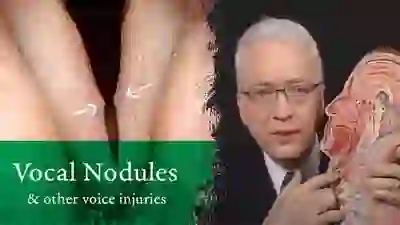
Nodules and Other Vocal Cord Injuries: How They Occur and Can Be Treated
This video explains how nodules and other vocal cord injuries occur: by excessive vibration of the vocal cords, which happens with vocal overuse. Having laid that foundational understanding, the video goes on to explore the roles of treatment options like voice therapy and vocal cord microsurgery.
Audio Example 1
Patient comments about the improvement of voice after surgical removal of a vocal cord polyp:
Audio Example 2
Voice quality, with a vocal polyp, BEFORE surgery:
Same patient, AFTER surgery:
